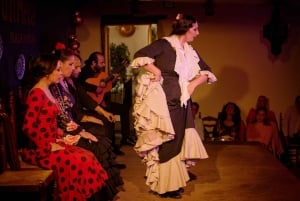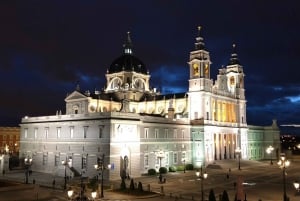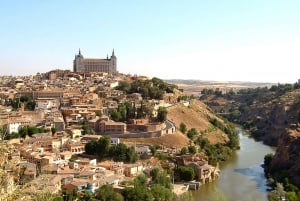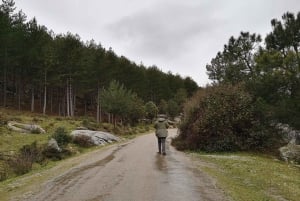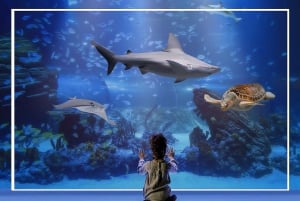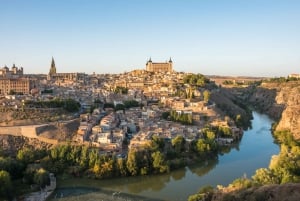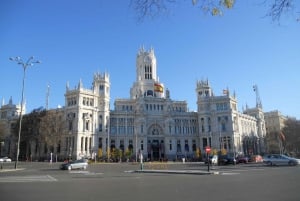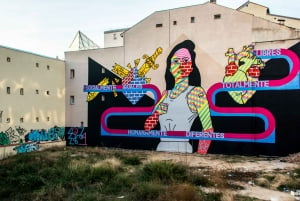Valle de los Caidos
El Escorial was the place chosen by King Felipe II to commemorate his victory over the French, but it was also taken by Franco to commemorate the fallen of both parties in the fratricidal Spanish Civil War (1936-1939). He raised a monument not less in terms of size than the Monastery, where the highest Christian cross ever built was erected that can be spotted from the outskirts of Madrid, more than 40 km away.
The Abbey of the Santa Cruz Valley of the Fallen is nestled in a rugged and uneven area, and is adorned with mountain vegetation like pine, oak and poplar, as well as washed by rivulets that supply the basilica's water.
The basilica is still run by Benedictine monks. It was built on the Sierra de Guadarrama between 1940 and 1958 where the dead of both parties are buried.
During the construction of the basilica many of the people employed in its construction were free workers, but some others were prisoners of the civil war who received a two day reduction in their sentence for each day worked. They also received other compensation depending on their job category.
Exterior
On top of the Basilica stands the highest Christian cross ever built, at 150m in height. It can be seen from 40 km away. The Cross was built without scaffolding, from inside like a chimney, being raised over the interior stairs. Access to the cross is by means of a cable car that ascends over a vertical drop of 125m in height or by a road with a ramp and stairs.
To enter the front esplanade of the basilica there are four large cylindrical monoliths of granite, 11.50 meters in height and 1.50 meters in diameter each, carved during the reign of Philip II.
The sculptor Juan de Avalos was able to fully integrate in perfect harmony the sculptures of the Four Evangelists on a set framed by the cross. These sculptures represent the four virtues: prudence, justice, fortitude and temperance.
At the door, made of bronze, a work of Fernando Cruz represents several of the mysteries of the Rosary, and the magnificent Piedad, a masterpiece by Juan de Avalos, is made of black stone from Zaragoza.
The abbey 262 meters long and 41m high at the centre of the transept is composed of two main bodies: the Abbey itself and the guest house reserved for guests carrying out cultural and religious activities. The inn is governed by the same principles that govern the abbey.
Adjacent to the main body of the abbey is the monks’ cemetery, which can only be visited by special request.
Over the gate accessing the nave, two angels with swords guard the entrance to the Abbey. They are made with bronze from cannons taken at war, as a sign that they are not going to be used anymore. On the fence, forty saints are depicted with the apostle Santiago, patron saint of Spain in the centre.
Interior
The basilica was excavated into the rock and it was necessary to remove 200,000 m3 of rock from the inside. The nave is divided into four sections with six chapels, including eight Flemish tapestries made in the sixteenth century with the iconography theme of the Apocalypse of St. John. What we see today are replicas of the twentieth century.
Throughout the nave there are six side chapels dedicated to various representations of the Virgin Mary, the patron of armies due of her links to important aspects of the history of Spain.
In each of the chapels there are two images of the Apostles made in alabaster forming the set of Twelve, with St. Matthias taking the place of St. Jude.
There is also a triptych in Flemish Gothic style from the fifteenth century at the front altar, in both cases representing scenes of Christ's and Virgin Mary's life.
In the spaces between each chapel are eight tapestries with scenes from the Apocalypse, a copy of a sixteenth century Flemish collection acquired by the Emperor Carlos I and brought to Spain by his son King Philip II. The originals are in the Palace of La Granja and these copies have significant value.
Behind the two side chapels of the cruise (Holy Sepulcher), lie the remains of the fallen of both parties during Civil War and from all regions of Spain as a sign of reconciliation.
In the left transept there is a tile used for central monitoring of earthquakes and other scientific studies.
Arriving at the center of the cruise we see the altar made of granite, on which a magnificent crucifix stands, sculpted by Julio Beovides and polychrome by Ignacio Zuloaga.
During the Mass, at the time of consecration, a spiritual effect is achieved by turning off all lights in the basilica to illuminate only the Christ, thus gaining a greater devotion to the liturgy.
The front of the altar is embossed in metal. At the front, the Entombment; in the back, the Last Supper; and on the sides, the symbols of the four evangelists: the bull of St. Luke, the lion of St. Mark, the angel of St. Matthew and the eagle of St. John.
At the Presbytery we can find four great archangels 7m in height made in bronze by Avalos, whose names are known thanks to the canonical texts of Scripture and by certain Old Testament Apocrypha: San Rafael, with the pilgrim's baton; San Miguel, with its sword; San Gabriel with a lily; and San Uriel, his head bowed and covered and hands held high in prayer, who according to Jewish tradition is the one who introduces the dead to God.


